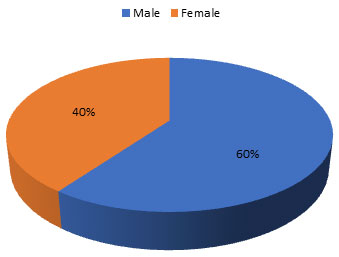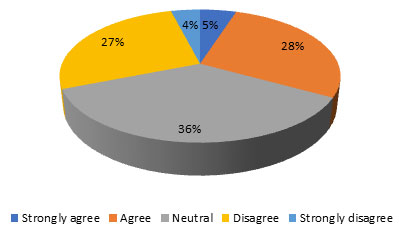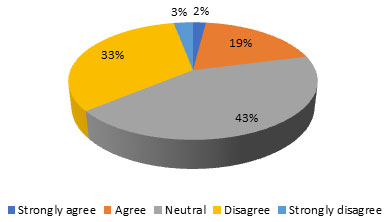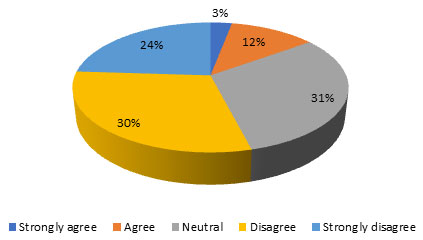1Oral Medicine and Diagnostic Sciences Department, College of Dentistry, King Saud University, Riyadh, Saudi Arabia.
2College of Dentistry, King Saud University, Riyadh, Saudi Arabia.
Corresponding author email: halbageah@ksu.edu.sa
Article Publishing History
Received: 07/04/2023
Accepted After Revision: 29/06/2023
The temporomandibular joint (TMJ) complex is mainly composed of bone, cartilage, muscles, ligaments, and neurovascular channels that supply the tissues. The temporomandibular disorders (TMD) are collective term embracing a number of clinical problems that involve the masticatory muscles, the temporomandibular joints (TMJs) and associated structures, or both. The most common symptoms of temporomandibular joint disorders (TMDs) are pain, noises in the joint, limitation of mouth opening, or a combination of these. The objective of this study was to assess the knowledge and management of temporomandibular joint (TMJ) disorders among dental interns at King Saud University, Saudi Arabia. The sample size of this study consisted of 100 dental interns at King Saud University. Informed consent from the participants was obtained.
The participants were informed that their responses and personal information would be kept confidential. A cross-sectional survey was prepared in English language using Google Forms. The survey contains 12 questions was distributed among the selected sample of dental interns at King Saud University. The average knowledge score of the dental interns on the knowledge regarding management of (TMJ) disorders was 4.04 (SD = 1.42). The maximum score obtained was 8 out of 8, the minimum was zero. that the majority of the dental interns (67%) had fair knowledge. The finding of the present study showed, there was a fair level of knowledge about (TMJ) disorders among dental interns. Many interns are unable to diagnose and treat patients suffering from temporomandibular joint disorders.
Temporomandibular Joint, Knowledge and Management, Disorders Among.
Albagieh H, Alghamdi A, Almefyaz M, Alshehri A, Alsaiady O. Knowledge and management Assessment of Temporomandibular Joint (TMJ) Disorders Among Dental Interns at King Saud University. Biosc.Biotech.Res.Comm. 2023;16(2).
Albagieh H, Alghamdi A, Almefyaz M, Alshehri A, Alsaiady O. Knowledge and management Assessment of Temporomandibular Joint (TMJ) Disorders Among Dental Interns at King Saud University. Biosc.Biotech.Res.Comm. 2023;16(2). Available from: <a href=”https://bit.ly/2U8EBeg“>https://bit.ly/2U8EBeg</a>
INTRODUCTION
The temporomandibular joint (TMJ) complex is mainly composed of bone, cartilage, muscles, ligaments, and neurovascular channels that supply the tissues. The temporomandibular disorders (TMD) are collective term embracing a number of clinical problems that involve the masticatory muscles, the temporomandibular joints (TMJs) and associated structures, or both. The most common symptoms of temporomandibular joint disorders (TMDs) are pain, noises in the joint, limitation of mouth opening, or a combination of these (Glick et al.,, 2015). The most common musculoskeletal diseases affecting the temporomandibular joint and associated structures in the orofacial region are temporomandibular joint disorders. Many dentists are unable to diagnose and treat patients suffering from temporomandibular joint disorders. the misdiagnosis of the orofacial pain of the temporomandibular joint associated with the dentoalveolar region, which leads to incorrect management (Al-Huraishi et al., 2020).
TMDs are diagnosed using a variety of methods including clinical examination, radiographic image such as: panoramic X-rays, conventional tomography (CT), Digital Volume Tomography, Arthrography, Magnetic Resonance Imaging (MRI), and Cone Beam-Computed Tomography (CBCT) (Petersson 2010). Pain relievers, nonsteroidal anti-inflammatory medications (NSAIDs), muscle relaxants, anticonvulsants (gabapentin), and tricyclic antidepressants (TCAs) are among the medications used to treat TMDs (López-Frías 2019).
Multiple researchers were assessing the knowledge of dental interns among different dental procedures, diseases and managements. In a study done by Hidayah Elyas to assess the knowledge, attitude, and practices of dental practitioners regarding temporomandibular joint disorders in Saudi Arabia they found most of the respondents were not confident enough in diagnosing, making a therapeutic decision, and assessing the treatment outcome of TMDs (Elyas et al. 2021).
In another study, Rabaa Aboubakr and Elkwatehy (2021) found that the knowledge level about TMDs was insufficient among undergraduates and dental intern students. The aim of this study was to assess the knowledge and management of temporomandibular joint (TMJ) disorders among dental interns at King Saud University, Saudi Arabia.
MATERIAL AND METHODS
The sample size of this study consisted of 100 dental interns at King Saud University. Informed consent from the participants was obtained. The participants were informed that their responses and personal information would be kept confidential. A cross-sectional survey was prepared in English language using Google Forms. The survey contains 12 questions was distributed among the selected sample of dental interns at King Saud University. The first three questions were designed based on an established Likert scale, the questions were related to the ability of undertake a clinical examination regarding TMJ, assess the treatment needs and management of TMJ and the third question was related to satisfaction of lectures and clinical training giving at undergraduate curriculum. The followed eight questions were to measure and assess the knowledge and management regarding temporomandibular joint (TMJ) disorders.
Data Analysis: All questionnaire data were included for analysis purposes in the SPSS 22 software (SPSS, Chicago, USA). Each element has been assigned to the value 1 in case of a correct answer and 0 if it is incorrect. Descriptive statistics were used to show the results in terms of frequencies, percentages, means and the standard deviation.
RESULTS AND DISCUSSION
The total number of participants in this study was 100. Participants were recruited in this survey, 60% males and 40% females.
Figure 1

Table 1. The total number of participants in this study (N=100):
| Frequency | Percent | ||
| GENDER | Male | 60 | 60.0% |
| Female | 40 | 40.0% | |
| Total | 100 | 100.0% | |
Competencies to undertake a clinical examination, assess the treatment needs and management regarding temporomandibular joint (TMJ) disorders: The participants were asked question about their competencies to undertake a clinical examination, assess the treatment needs and management regarding temporomandibular joint (TMJ) disorders. The results were presented in the following tables:
Table 2. Competency to undertake a clinical examination (N=100):
| Responses | No | Percent | Mean | SD |
| Strongly agree | 5 | 5.0 | 3.03 | 0.96 |
| Agree | 28 | 28.0 | ||
| Neutral | 36 | 36.0 | ||
| Disagree | 27 | 27.0 | ||
| Strongly disagree | 4 | 4.0 | ||
| Total | 100 | 100.0 |
As shown in Table 2, that only 33% of dental interns were able to undertake a clinical examination regarding (TMJ) disorders and reach to the correct diagnosis, while 31% of them reported they do not have the ability to undertake a clinical examination regarding (TMJ) disorders and reach to the correct diagnosis. However, the high percentage of participants were not sure about that i.e. (did not give an exact response). Moreover, the average response toward this question was (3.03± 0.96) which tend to be neutral.
Figure 2

Table 3. Competency to assess the treatment needs and management (N=100):
| Responses | No | Percent | Mean | SD |
| Strongly agree | 2 | 2.0 | 2.84 | 0.84 |
| Agree | 19 | 19.0 | ||
| Neutral | 43 | 43.0 | ||
| Disagree | 33 | 33.0 | ||
| Strongly disagree | 3 | 3.0 | ||
| Total | 100 | 100.0 |
As shown in Table 3, the high percentage of participants (43%) (mean ±SD 2.84, 0.84) were not sure about their ability to assess the treatment needs and management regarding (TMJ) disorders, while 36% were not able to do that. However, only 21% of dental interns were able to assess the treatment needs and management regarding (TMJ).
Figure 3

Satisfaction of lectures and clinical training during undergraduate curriculum to diagnosis and manage (TMJ) disorders: The participants were asked question about if they are satisfied about the coverage of lectures and clinical training during undergraduate curriculum to diagnose and manage (TMJ) disorders. The result was presented in the following table:
Table 4. Satisfaction of lectures and clinical training (N=100):
| Responses | No | Percent | Mean | SD |
| Strongly agree | 3 | 3.0 | 2.40 | 1.07 |
| Agree | 12 | 12.0 | ||
| Neutral | 31 | 31.0 | ||
| Disagree | 30 | 30.0 | ||
| Strongly disagree | 24 | 24.0 | ||
| Total | 100 | 100.0 |
As shown in Table 4, more than half of dental interns (54%) reported that lectures and clinical training covered during undergraduate curriculum were not enough to diagnose and manage (TMJ) disorders. However, 31% were neutral about that i.e. (did not give an exact responses). On the other hand, only 15% of participants reported that lectures and clinical training covered during undergraduate curriculum were enough to diagnose and manage (TMJ) disorders.
Figure 4

Knowledge and management of (TMJ) disorders among dental interns at King Saud University: In this section of the study the knowledge and management of (TMJ) disorders were assessed among dental interns at King Saud University in Saudi Arabia.
Table 5. Frequency distribution of true and false answers on [knowledge about TMJ disorder (n=100)
| Answers | ||
| Items | Correct | Incorrect |
| Which of the following statements is true regarding the temporomandibular joint? | 38% | 62% |
| Ankylosis of the temporomandibular joint (TMJ) is defined as immobility or fusion of the joint. This condition most often results from which of the following? | 68% | 32% |
| A 23-year-old former ballet dancer came to your clinic complaining of a loud clicking sound in both sides of her TMJs without any pain, her mouth opening is 55mm, with slight deviation to the right then to the left, started suddenly 16 months ago, during examination; clicking sound existed even after mandibular advancement, the most probably diagnosis for this case is | 24% | 76% |
| A well-nourished 41-year-old female patient present with a chief complaint of painful limited mouth opening, her mouth deflects to the right side while opening, she reported receiving a trauma from her teenage son one week ago. What is the most probable diagnosis for this case? | 56% | 44% |
As shown in Tables 5, regarding dental interns’ knowledge about (TMJ) disorders at King Saud University, that the overall percentage of correct answers to this subscale was 46.5%.
However, the results revealed that 68% of dental interns were knowledgeable that Ankylosis of the temporomandibular joint (TMJ) most often results from Trauma or infection. Moreover, 56% of dental interns had the knowledge that the most probable diagnosis for the case (A well-nourished 41-year-old female patient present with a chief complaint of painful limited mouth opening, her mouth deflects to the right side while opening, she reported receiving a trauma from her teenage son one week ago) was acute disc displacement without reduction in the right TMJ.
Moreover, the majority of dental interns involved in this study failed to answer the item (A 23-year-old former ballet dancer came to your clinic complaining of a loud clicking sound in both sides of her TMJs without any pain, her mouth opening is 55mm, with slight deviation to the right then to the left, started suddenly 16 months ago, during examination; clicking sound existed even after mandibular advancement, the most probably diagnosis for this case is) correctly by 76%. Also, 62% of dental interns failed to answer item (Which of the following statements is true regarding the temporomandibular joint?) correctly.
Table 6. Frequency distribution of true and false answers on [management regarding TMJ disorder (n=100)
| Answers | ||
| Items | Correct | Incorrect |
| A 35-year-old female teacher came to your clinic complaining of severe pain in the left side of her jaw started three months ago, her medical history was significant for systemic osteoarthritis, that she’s been diagnosed last year. Her pain is severe with dull aching quality. She is using paracetamol but it doesn’t help anymore, her mouth opening is limited because of the pain. The best way to control the pain in this case is achieved by: | 10% | 90% |
| In painful anterior disc displacement cases, which one of the following modalities is the best way to control pain? | 51% | 49% |
| A 23-year-old former ballet dancer came to your clinic complaining of a loud clicking sound in both sides of her TMJs without any pain, her mouth opening is 55mm, with slight deviation to the right then to the left, started suddenly 16 months ago, during examination; clicking sound existed even after mandibular advancement, the most probably diagnosis for this case is: | 13% | 87% |
| Dislocation is treated by forcing the mandible | 70% | 30% |
As shown in Tables 6, regarding dental interns’ knowledge about (TMJ) disorders at King Saud University, that the overall percentage of correct answers to this subscale was 36%.
However, the results revealed that the most item pertained to management of (TMJ) disorders that dental interns aware about the treatment of dislocation, that 70% of dental interns had the knowledge that dislocation is treated by forcing the mandible downward and backward. As well, 51% of dental interns had the knowledge that best way to control painful anterior disc displacement cases was by administering non-steroidal anti-inflammatory drugs.
Moreover, that the most item that dental interns failed to answer correctly was “A 35-year-old female teacher came to your clinic complaining of severe pain in the left side of her jaw started three months ago, her medical history was significant for systemic osteoarthritis, that she’s been diagnosed last year. Her pain is severe with dull aching quality. She is using paracetamol, but it doesn’t help anymore, her mouth opening is limited because of the pain. The best way to control the pain in this case is achieved by:”, 90% of them failed to answer this item correctly.
Also, 87% of dental interns involved in this study failed to answer the item “A 23-year-old former ballet dancer came to your clinic complaining of a loud clicking sound in both sides of her TMJs without any pain, her mouth opening is 55mm, with slight deviation to the right then to the left, started suddenly 16 months ago, during examination; clicking sound existed even after mandibular advancement, the most probably diagnosis for this case is“
Knowledge scores regarding Knowledge and management of (TMJ) disorders among dental interns at King Saud University: The knowledge score was classified as follow: Poor knowledge (<4) , Fair knowledge (4-6) and good knowledge (7-8) (Table 7).
Table 7. Knowledge scores regarding TMJ (n=100).
| Knowledge Level | No. | Percentage | ||||||
| Poor (<4) | 31 | 31% | ||||||
| Fair (4-6) | 67 | 67% | ||||||
| Good (7-8) | 2 | 2% | ||||||
| Total | 100 | 100.00% | ||||||
| Correct answers | Min. | Max. | Mean | SD | ||||
| 0 | 8 | 4.04 | 1.42 | |||||
As shown in the above Table, that the average knowledge score of the dental interns on the knowledge regarding management of (TMJ) disorders was 4.04 (SD = 1.42). The maximum score obtained was 8 out of 8, the minimum was zero. As presented in Table 6, that the majority of the dental interns (67%) had fair knowledge. Many studies have been done to assess the knowledge and management regarding TMDs among general practitioners and dental students but none of them has been done on dental interns. This the study has been conducted on dental Interns only.
According to the current survey, the average score of the dental interns on the knowledge and management regarding (TMJ) disorders was fair. The participants were asked question about if they are satisfied about the coverage of lectures and clinical training during undergraduate curriculum to diagnose and manage (TMJ) disorders, the result was more than half of dental interns (54%) reported that lectures and clinical training covered during undergraduate curriculum were not enough to diagnose and manage (TMJ) disorders.
Many studies have been conducted to assess the level of knowledge and management regarding TMDs among general dental practitioners (GDPs) and dental students. Aboubakr and Elkwatehy (2021) study which was conducted among undergraduate dental students and interns revealed that the knowledge level among the participants regarding TMDs was not sufficient as the percentage of participants who answered correctly to the questions was less than 50% for all questions except in two questions they were more than 50% which were asking about the common medications prescribed for TMDs, another survey by Elyas et al. (2021) revealed that general dental practitioners had fair level of knowledge regarding TMDs.
This finding is also in accordance with a survey by Patil and Iyengar (2016) showed evident that GDPs had fair level of knowledge regarding TMDs, whereas the majority of the experts had a good level of knowledge. Thus, a significant difference in the level of knowledge was observed between the two groups. Also, Rahmeier et al. (2021) revealed that the students had little knowledge regarding TMD and bruxism due to the insufficient credit hours offered by the curriculum. Le Resche et al. (1993) reported that general dental practitioners (GDPs) had low knowledge level regarding pathophysiology, diagnosis and treatment in comparison to TMDs specialists. However, Ashwin and Siri (2018) revealed good knowledge level among their postgraduate participants. In addition, López Frías et al. (2019) showed sufficient knowledge among postgraduate students regarding etiology and diagnosis of TMDs in comparison to lower knowledge in management of the same condition among their GDPs participants.
In dentistry and educational programs regarding TMDs, importance is given to applying and converting learned knowledge to diagnose and manage TMDs in clinical practices. Thus, the current study emphasizes the importance of developing and improving undergraduate curricula to provide dental practitioners with both theoretical and practical knowledge regarding the diagnosis and management of TMDs. Continuing dental education programs, fellowships, and TMJ workshops may help dental practitioners to improve their skills and knowledge.
CONCLUSION
The anatomy and pathophysiology of the TMJ are important topics in the curriculum of dental students that help with the proper diagnosis and management of TMJ disorders. The finding of the present study showed, there was a fair level of knowledge about (TMJ) disorders among dental interns. Many interns are unable to diagnose and treat patients suffering from temporomandibular joint disorders. Further studies on a larger scale with a larger sample size are required to get a proper overview regarding this topic among dental interns.
Ethical approval: This article does not include any studies involving human participants or animals performed by the author. An exemption letter was provided by the Institutional Review Board (IRB) (No. E-22-7415).
Funding: This research did not receive any specific grant from funding agencies in the public commercial or not for profit sectors.
REFERENCES
Aboubakr, R., & Elkwatehy, W. (2021). Knowledge about temporomandibular joint disorders among dental students in Saudi Arabia. Egyptian Dental Journal, 67(4), 2885-2892.
Al-Huraishi, H.A., Meisha, D.E., Algheriri, W.A., Alasmari, W.F., Alsuhaim, A.S. and Al-Khotani, A.A., 2020. Newly graduated dentists’ knowledge of temporomandibular disorders compared to specialists in Saudi Arabia. BMC Oral Health, 20, pp.1-9.
Ashwin, P.S. and Siri, P.B., 2018. Assessment of knowledge, attitude and practice on temporomandibular joint disorders among post-graduate dental students. Int J Dent Res, 3(4), pp.59-62.
Elyas, H., Alomran, S., Almosharraf, E., Alomar, G. and Alkharaan, M., 2021. Assessment of knowledge, attitude, and practices of dental practitioners regarding tempromandibular joint disorders in Saudi Arabia. International Journal of Medicine in Developing Countries, 6(1), pp.6-13.
Glick, M., 2015. William M. Burket’s Oral Medicine. 12th ed. People’s Medical Publishing House: USA, pp.104-8.
Le Resche, L., Truelove, E.L. and Dworkin, S.F., 1993. Temporomandibular disorders: a survey of dentists’ knowledge and beliefs. Journal of the American Dental Association (1939), 124(5), pp.90-4.
López-Frías, F.J., Gil-Flores, J., Bonilla-Represa, V., Ábalos-Labruzzi, C. and Herrera-Martinez, M., 2019. Knowledge and management of temporomandibular joint disorders by general dentists in Spain. Journal of clinical and experimental dentistry, 11(8), p.e680.
Patil, S. and Iyengar, A.R., 2016. Assessment of knowledge, attitude and practices of dental practitioners regarding temporomandibular joint disorders in India. Journal of Advanced Clinical and Research Insights, 3(2), pp.64-71.
Petersson, A., 2010. What you can and cannot see in TMJ imaging–an overview related to the RDC/TMD diagnostic system. Journal of oral rehabilitation, 37(10), pp.771-778.
Rahmeier, G., Irineu, G.L., Maracci, L.M., Salbego, R.S., Nascimento, L.P., Marquezan , Silva, B. 2021. Dental students’ knowledge assessment of TMD and Bruxism at UFSM. Revista da ABENO, 21(1), pp.1-10. DOI: 10.30979/revabeno.v21i1.1253.


